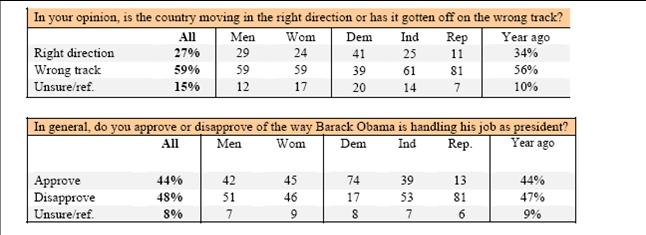We are witnessing a fascinating struggle between the polling data in Iowa, and how Republican Party leaders and pundits are interpreting that data. Yesterday, the National Journal ran this story under the headline “Romney: The New Frontrunner in Iowa”. It linked to a number of print and online articles that collectively indicated Romney was poised to win the Jan. 3 caucus and position himself to close out the nomination contest shortly thereafter. Thus, Politico proclaimed that “Romney was in striking distance of Iowa Win.” The Washington Post proclaimed that Romney’s “stealth campaign” gave him a “real shot at winning Iowa.” This Huffington Post piece ran under the headline “Romney poised to do well in Iowa.” The Hill opined that Romney “could lock up GOP nod with win at Iowa.” The Los Angeles Times went so far as to claim that Romney could “win” Iowa even if he didn’t win there! Josh Krashauer concludes his National Journal piece with this confident assertion: “Make no mistake: If Romney wins the Iowa caucuses, he’s on a glide path to the Republican nomination. And with newfound scrutiny over Paul’s racial record, Gingrich losing momentum and the evangelical base vote split between Bachmann, Perry and Santorum, it’s looking awfully likely that Romney will come away as the big winner on Jan. 3.”
Big Winner? You might think this assessment and the accompanying flurry of news story touting Romney’s prospects are driven by recent polling data indicating that Romney was pulling ahead in Iowa, or at least that his poll numbers were on the rise there. But you would be wrong. The reality is that there are no signs of a Romney surge in Iowa. At best one might argue that he’s climbed a couple of percentage points back to where he was a month ago, but even that’s uncertain, given the probabilistic nature of survey sampling.
Consider the latest Iowa poll released late yesterday by Insider Advantage. It shows Romney at 17.2%, in a dead heat with Paul (17.3%) and Gingrich (16.7%). (The bigger news in the poll is that Santorum has climbed to 4th, at 13.4%, which is consistent with yesterday’s CNN/ORC poll that had him third, with 16% of the polling support. More on that in a later post.) One week ago Insider Advantage had Romney at…. 18%. Well, that’s one poll you say – surely he’s climbing in all the others? Nope. PPP’s latest had Romney at 20% – exactly where he was a week before in the previous PPP poll. Rasmussen? The last two polls, again a week apart, have him at 23% and 25%. Really the only poll that suggests any growth in Romney’s support is yesterday’s CNN poll, which has him at 25%, which is 5% more than its previous poll. That previous poll, however, dates back three weeks.
Indeed, right now Romney is at 21.8% in the RealClearPolitics composite polling tracker – which is almost exactly where he was a month ago and, in fact, about where he was last July! Indeed, he’s on track to finish below the 25% he received in Iowa four years ago! For all intents, despite several millions dollars of paid advertising, countless visits, endorsements by party leaders, and even a change in clothing (Mitt’s ditched the prep look and is now dressing down) Romney’s been treading water for four years in Iowa. That’s the real story.
Look, Romney could very well finish first come Jan. 3 – but if current trends hold it won’t be because of a surge of support in the last two weeks of the race. Iowan voters show no signs of coming around to Mitt. It will be because unlike in 2008, the Tea Party/evangelical voters who comprise more than 50% of the likely caucus voters didn’t coalesce behind a single alternative candidate. Their failure to do so make it possible that Romney’s support will go down from 2008 – and yet he will finish first.
If that happens, it will be very interesting to see how the media spins the results. For reasons that I think must be based on evaluations of candidate electability, the Republican party establishment – by which I mean party leaders (see his endorsers) and their media counterparts (think Will, Brooks, and Krauthammer) – are completely in the tank for Romney, despite the fact that he has yet to demonstrate deep or broad support among hard-core Republican partisans. There’s a dispute in the political science literature regarding whether the winning candidate gets a boost from Iowa. (I’ll address this in a separate post.) But it partly depends on media reactions and the expectations game. If Mitt can’t increase his support in Iowa from four years ago, that suggests he’s not gaining strength as a candidate. But that may not be how the media interprets the results.
By the way, the Insider Advantage poll released late yesterday showing a three-way tie in Iowa included 69% Republicans, 27% independents, and 3% Democrats – that’s a relatively low number of Republicans, which suggests the poll may be slightly understating Santorum’s support although it’s hard to be sure without an ideological breakdown as well. The other interesting finding is what appears to be a gender gap in both Paul’s and Romney’s support; Paul leads among men with 23% of the vote, but he gets only 12% among women. Romney’s support is reversed; he receives the highest support among women, with 23%, but only gets 11% from men. Gingrich, in contrast, polls equally well with both genders (17%). Indeed, of the three front-runners, Gingrich shows the most consistent support across party, gender and age lines. He comes in second among Republicans, second among Democrats and third among independents. And while Paul draws disproportionally from those 44 years old and younger, and Romney’s core support is from the 45 and older crowd, Gingrich draws about evenly from all age groups. Maybe Gingrich, and not Romney, is most electable?








